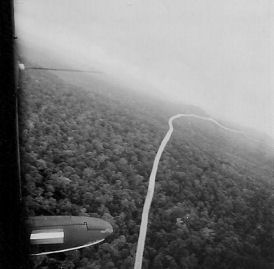In the Far East with the 'Forgotten Army'
During WW2. whilst the Japanese occupied Malaya (5th Feb.1942-August 1945) members of the British Force 136 were hidden away in the Malayan jungle training soldiers, mainly of Chinese origin, the art of jungle fighting. Later British weapons and ammunition were parachuted to them and secreted in various hide-outs.

One of those jungle fighters, a Lan Yew, had led the Malay delegation to London for the Victory Parade (he was military adviser to Chin Peng Leader of the Malayan Peoples Anti-British Army) said at that time to be 5000 strong and funded by the Chinese Communist Party. Chin Peng had been awarded the O.B.E. (Order of The British Empire) for his resistance work against the Japanese during WW2 in Malaya.
These people considered that by the inflicting of terror a well organised minority could defeat a nation.
On June 16th 1948, three British Managers of rubber plantations were murdered. This was the start of years of terror for the Malayan inhabitants. In July 1948 a state of emergency was declared. A few days later Lan Yew was shot dead.
1949 was a bad year for the security forces. Morale in Malaya reached an all time low in January 1950 when the then British Labour Prime Minister Clement Atlee recognised on behalf of the British Labour government , Mao Tse Tung as the official Chinese Leader. The very man who was responsible for supplying the C.T. in Malaya with its needs.
On 23rd March 1950 84 Sqdn. was ordered back to Tengah on Singapore Island.

This was the scenario that greeted 84 Sqdn when it arrived at Tengah in April 1950 led by Sqdn. Leader George Unwin. D.F.M. The Sqdn's first airstrike was carried out 6 days after their arrival and thereafter strikes were almost a daily occurrence, the overall numbers dependant on the availability of Bristol Brigands being serviceable, this to a large extent on spare parts being available in Malaya when required. 84 Sqdn's 3 months attachment became three years.

Further Brigand Problems.
In WW2 the administration by the War Ministry must have been very difficult to handle with units/sqdn's continually on the move, but one would have thought that with the cessation of hostilities things would have improved and yet 45 and 84 Sqdn's were unable most times from 1945 onwards to get spares delivered as a matter of urgency , and not find that after they had been moved to a new base, that these spares and systems desperately needed had been delivered late and to the base they had already vacated.
This state of affairs was not to improve during 84 Sqdn's period of 'active service' in Malaya, consequently very seldom were aircraft available, due to lack of equipment, mainly spares and armaments.
The storage of the Bristol Brigand aircraft at Filton where moisture was able to penetrate between joints and around fasteners, probably started the weakening of the structures (I remember that we had some very cold, frosty, snowy and wet winters and then hot summers in the years 1944 to 1948, not like the gentle weather we now moan about). So bearing this in mind it is little wonder that some crystallisation occurred where the wings were connected to the fuselage.
Also a major problem Brigands had, was the hydraulic systems which seems certain to have been caused by the various seals being totally unsuitable and of their deterioration even during the storage period.The hydraulic pumps on the undercarriage proved an insurmountable problem and quite a number of Brigands were 'written off' after having to carry out 'belly landings' when their undercarriage failed to lock down.
